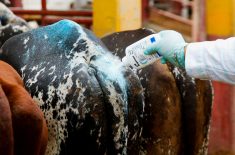A sharp drop in feed corn prices caused by the huge U.S. harvest last month has put the nation’s cattle feedlots in the black for the first time in more than two years.
But analysts warn those profits could soon disappear as the prices they pay for scarce lightweight calves remain near record high.
Feedyards and packing plants, such as Cargill and Tyson Foods, are drawing from a shallow pool of cattle after multi-year droughts in the country whittled the herd to its lowest in more than 60 years.
Read Also

U.S. grains: Soy futures post biggest monthly gain in nearly five years on China trade optimism
U.S. soybean futures climbed to a 15-month high and posted their biggest monthly gain in nearly five years on Friday following a rally fueled by the prospect of revived exports to China.
The Denver-based Livestock Marketing Information Center (LMIC) calculated that feedlots in October, on average, made about $39 per head on cattle sold to meat companies (all figures US$). That compares with a loss of $21 per head in September, which was the 29th consecutive month of losses.
Feedlots last month saw less red ink on their books largely because farmers reaped a bountiful fall harvest, which sank the price for corn, the main ingredient in livestock feed, to its lowest in three years.
In October, the price for 651- to 700-pound yearling steers at the benchmark Oklahoma City National Stockyards Co. peaked at their highest ever at $174 per hundredweight (cwt), according to stockyard sources.
Those prices have since come down to an average of about $169/cwt last week, based on USDA data. That price reduction coincided with costs for slaughter-ready cattle that pulled back from last month’s record-high of $132/cwt to roughly $130 to $131 last week.
Feedlots made money on feeder cattle that they purchased four to five months prior to them surging in October, said Denver-based LMIC’s director Jim Robb.
Even with the decline in the costs for feedstuffs, cattle feeding returns will be tempered by record high feeder cattle values, said Robb, who forecast a likely return to losses by feedyards as soon as December of this year.
“We have ratcheted up feeder cattle prices to such high levels that we won’t see that euphoria for placing cattle in feedlots in the months ahead,” he said.
Armed with less-expensive corn, feedyards continue to snatch up available feeder cattle to offset surplus feeding pen space. They are also guided by the belief those animals will be worth even more as ranchers restock herds amid tight supplies.
“With roughly 10 million cattle on feed in feedlots that can hold more than 1,000 head, you’re only using about 60 percent of bunk or feedlot capacity,” said Elaine Johnson at CattleHedging.com in Denver, Colorado.
“You’ve got a lot cheaper corn than you use to and most feedlots are selling cattle with a little profit, which has ignited competition to fill the feedlots.”
John Nalivka, president of Sterling Marketing at Vale, Oregon, said that, even though corn prices have come down well below a year ago, feedlots have had to invest the margin opportunity in feeder cattle as those supplies have tightened, likely resulting in little or no profit gain.
Nalivka calculated feedlot break-evens for the young cattle currently being placed on feed in the low-to-mid $130s. These break-evens compare with the upper $120s for cattle that are now being marketed and is the result of record prices paid for feeder cattle and calves, he said.
“It’s a hustle to make as many of these $100 per head margins as possible before the hammer comes down again, and it will,” Nalivka added.
— Theopolis Waters reports on livestock markets for Reuters from Chicago.











